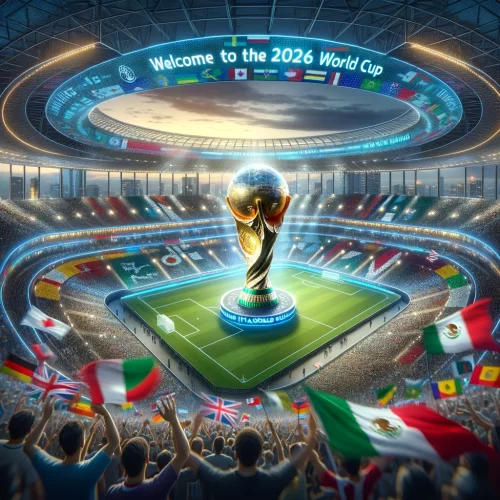
Get ready for a historic event! The 2026 FIFA World Cup, officially known as FIFA World Cup 26, is set to be the biggest and most expansive iteration of the prestigious tournament yet. Held across 16 cities in Canada, Mexico, and the United States, it will mark the first tri-nation hosting and the debut of a 48-team format.
A Tournament Steeped in History:
The FIFA World Cup, dating back to 1930, is the pinnacle of international men’s soccer. Every four years, nations vie for the coveted trophy, uniting fans worldwide in a celebration of athleticism, passion, and national pride. The 2026 edition carries the legacy of this rich history, promising an unforgettable experience for players, fans, and the host nations.
Highlighting the Uniqueness of 2026:
- Tri-Nation Spectacle: For the first time ever, the World Cup will be jointly hosted by Canada, Mexico, and the United States. This collaboration offers a diverse cultural tapestry and unique travel experiences for fans venturing across borders.
- Expanded Format: Brace yourself for more drama and competition! The 2026 tournament introduces a 48-team format, up from the usual 32. This opens doors for more nations to participate, potentially bringing new rivalries and upsets to the forefront.
- North American Debut: Since 1994, the World Cup hasn’t graced North American soil. The 2026 edition marks a triumphant return, generating immense excitement among local fans and promising a booming economic impact for the host cities.
Current Developments and What to Expect:
- Schedule and Venues: While the exact dates are yet to be finalized, the tournament is expected to run from June to July 2026. The host cities and stadiums have been selected, with iconic venues like MetLife Stadium (New York/New Jersey) and Azteca Stadium (Mexico City) gearing up for the grand stage.
- Qualification Draw: The qualification process is already underway, with national teams across the globe battling for their spots in the coveted 48 slots. The draw for the final tournament is expected to take place in late 2025.
- Anticipation Builds: As the months progress, the anticipation for the 2026 World Cup is steadily rising. Fans are eagerly awaiting the qualification results, the official schedule announcement, and the opportunity to secure their tickets for this once-in-a-lifetime event.
Mark your calendars, football fans! The 2026 FIFA World Cup promises to be an unprecedented celebration of the beautiful game. With its historical significance, innovative format, and tri-nation flavor, this tournament is poised to be a landmark event, leaving a lasting impact on the world of soccer and beyond.
Stay tuned for further updates and exciting news as the 2026 FIFA World Cup approaches!
Article above assisted by Google Bard, article below assisted by ChatGPT.
The 2026 FIFA World Cup: A New Era of Global Football
Introduction The 2026 FIFA World Cup is set to redefine international football with groundbreaking changes, embracing an expanded format, and welcoming the globe to North America. This tournament, the 23rd in the illustrious history of the FIFA World Cup, promises to blend tradition with innovation, showcasing the unifying power of football on an unprecedented scale.
Historical Context Since its inception in 1930, the FIFA World Cup has evolved into the pinnacle of international football competition. The 2026 edition marks several firsts: it will be the first World Cup hosted by three nations—Canada, Mexico, and the United States; the first in North America since the United States hosted it in 1994; and the first to feature 48 teams, up from the traditional 32. This expansion not only reflects the growing global footprint of football but also honors the diverse and rich footballing cultures across the North American continent. Mexico will become the first country to host or co-host the men’s World Cup three times, while Canada will be hosting for the first time, and the US for the second time.
Format and Expansion A significant change in the 2026 FIFA World Cup is the expanded team format, growing to include 48 national teams divided into 12 groups of four. This format adjustment is designed to increase participation and fan engagement worldwide, showcasing a wider array of talents and stories. The tournament will feature 104 matches over a span of 38 to 40 days, ensuring a packed schedule of excitement and competition. This format aims to preserve the quality of play while offering new opportunities for nations to shine on the world stage.
Host Selection Process The selection of the United States, Canada, and Mexico as co-hosts came through a comprehensive and competitive bidding process, reflecting FIFA’s commitment to fairness and transparency. The joint bid by these three countries was chosen over Morocco’s bid, highlighting the appeal of a multi-nation hosting model and the robust football infrastructure in North America. The decision also aligns with FIFA’s vision of expanding the game’s global reach and fostering unity through sport.
Venues and Cities The 2026 FIFA World Cup will leverage the vast and varied landscapes of North America, with matches spread across iconic cities and state-of-the-art stadiums in Canada, Mexico, and the United States. This selection of venues underscores the tournament’s ambition to deliver a unique and diverse footballing experience, reflecting the cultural mosaic of the host nations. Each city was chosen for its ability to provide world-class facilities, vibrant atmospheres, and a warm welcome to fans from around the globe.
Conclusion The 2026 FIFA World Cup stands as a testament to football’s enduring power to unite people across different backgrounds, nationalities, and cultures. With its innovative format, inclusive hosting strategy, and commitment to excellence, this tournament is poised to mark a new chapter in the history of the beautiful game. As preparations continue, the excitement builds for what promises to be a celebration of football like no other, setting new standards for global sports events in the 21st century.








